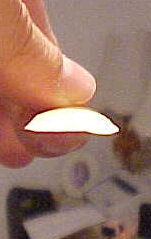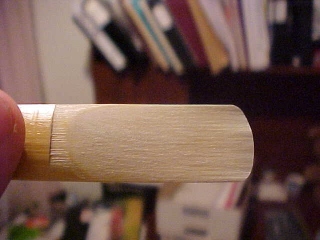
How to Fix Warped Reeds
This Online Lesson is (c)
2001
Ryan Fraser. All right reserved. NO COMMERCIAL DISTRIBUTION.
THIS LESSON HAS BEEN DOWNLOADED AND PRINTED FROM WWW.RYANFRASER.COM. YOU MAY USE THIS DOCUMENT FOR YOUR OWN USE, PROVIDED THAT YOU ACKNOWLEDGE THE SOURCE. PLEASE DO NOT PHOTOCOPY. THE CONTENTS OF THIS DOCUMENT MAY CHANGE FROM TIME TO TIME.
Its the nightmare of every saxophone player - one day you have the most wonderful sounding
reed in the world, and the next day - poof! You're stuck with this piece of wood that's become
massively warped or winkled. Now it just sounds like you are playing on tissue paper. What are
you going to do?
What causes warping?
In order to understand what has happened to your reed, we need to talk a little bit about plant
biology. Your reed, after all, was once part of a living plant. The latin name for this plant is
Arundo Donax. In english, we often call this "Reed Cane". Much like Bamboo or Sugar
Cane, Reed cane is a tall, slim cane, which is generally evenly round. The cane is native to the
Mediterranean region, although it has been spread as a decorative garden plant to the southern
United States. Unfortunately, it spreads quite prolifically, and has become a major
environmental pest in many areas, particularly in California. But enough about that - lets talk
warping!
You've probably had celery at some point in your life. Remember those stringy bits that get
caught in your teeth? Almost every plant has the same little strings - they're actually little tubes
called Xylem and Phloem. These tubes carry water and other nutrients to
locations throughout the plant. If you look at your reeds, you should be able to see these tubules
quite clearly on the flat (bottom) of the reed. You can also see them along the top, and the butt.
Here's a neat-o (and somewhat disgusting!) trick you can try: Take out a brand-new read,
and lick on a generous portion of saliva onto the top of the reed. (Don't put it on the bark, only
on the cut area.) Now, blow through the butt of the reed, as if it were a straw. You should find
that the saliva will start to bubble up. Guess what? You just used the Xylem and the Phloem
tubes to push air through the reed.
By now you are probably wondering what this has to do with warped reeds, right? Well,
before you wet your reeds, the Xylem and Phloem are filled with air. Furthermore, the walls of
these tubules are much denser than the surrounding material, otherwise the plant would loose all
of its nutrients into the surrounding tissue. This means that your reed has a variety of unequal
densities. It is these areas of uneven density that cause your reed to warp.
 |
Here is what happens: after you wet your reed to play it, the water in your saliva spreads
evenly throughout the reed, filling up the driest and least dense areas first. (Such as the inside of
the Xylem and Phloem - they are hollow, and have only the density of air.) As you continue to
wet the reed (or play on it, and have your saliva absorbed), the water begins to spread evenly
throughout the reed. As this happens, the various parts of the reed begin to expand in order to
accommodate the extra mass of the water. After you stop playing, the opposite happens - the
reed shrinks as the moisture evaporates. However, the first areas to dry out are the areas with the
lowest density - so they shrink faster than other areas with a higher density. This happens
throughout the reed, but is most noticeable around the tip of the reed, where the cane is so thin,
that the uneven shrinkage actually causes the reed to warp. You can get a similar effect by taking
a partially blow-up balloon, and pinching (shrinking) the skin. As you pinch the skin, the surface
will create warp or wrinkle to counteract the force you apply by pinching.
So how do I Get Rid of It??!!
In my opinion, 95% of all warping problems can be solved by letting your reed soak fully
immersed in water for several minutes. I always play with my reeds 100% saturated with water.
This usually forces out any wrinkles. This tends to even out any inconsistencies in the reed.
Furthermore, this way I always play my reeds with the same level of moisture, regardless of the
humidity of the air. (Admittedly, a dry room will dry out my reed faster than a humid room, but
at least I'm always starting with it the same way every time.)
If saturating the reed doesn't work, a second solution would involve carefully sanding the
reeds AFTER saturation. Get 800 grit or higher wet/dry sandpaper, and carefully sand away any
remaining warpage.
A note of CAUTION
Many players suggest wetting the reed (not soaking), and then pressing down with your
thumb on the tip of the reed with the reed pressed against the flat part of your mouthpiece. This
helps in the short term, by forcing the water to even out the reed, but in the longer term, it still
won't solve the problem, as the water will return after a few minutes to the less dense parts of the
tip. This will let you have a good sound for only a few minutes until the problem returns. I still
prefer saturating the reed completely - you will probably find that you have a much longer time
period before problems return.




